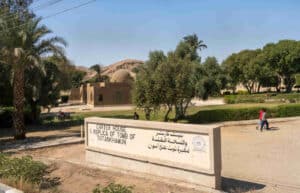The Catacombs of Alexandria, also known by their local name Kom el-Shoqafa, are one of the most surprising and unknown attractions of this city on the Mediterranean coast. If you are curious to know what they hide and why they are worth visiting, keep reading this post where we give you the basic information about this place built between the 4th and 5th centuries, and rediscovered at the beginning of the 20th century.
Catacombs in Alexandria?
The first question that may come to your head is: how is it possible that there are catacombs in the Egyptian city of Alexandria? And it must be clarified that, in this case, the concept of catacombs is not the one indicated by the DRAE (“Undergrounds in which the primitive Christians […] buried their dead”). The term ‘catacombs’ refers to the underground burial, but it is not a Christian cemetery, although its dating does coincide with that primitive era of said religion, whose believers were buried in this way between clandestinity and the oversight of the authorities.
In this case, we are in front of an underground burial site, with galleries and chambers with niches, where the most striking thing is the syncretism between the Egyptian, the Greek and even the Roman that occurred in this city, which became the capital of Ancient Egypt in times of Ptolemaic and Roman domination.
With a little observation and with the help of a guide, it is possible to guess details as significant of the decoration as the majestic reliefs of the entrance, where two large Anubis (guardian god of the underworld for the Egyptians) appear dressed as Roman legionaries, as sentinels, and equipped with snake tails, perhaps inspired by the Greek Agatodemon, which was later assimilated by Christianity as a guardian angel.
References to other divinities of antiquity, such as the Apis bull, the goddess Demeter or Persephone/Proserpina coexist with paintings or reliefs where you can see the classic mummification process, which tells us about the coexistence of cultures and religions that occurred in this multicultural city.
What Spaces are in the Catacombs of Alexandria
The Catacombs of Alexandria are an authentic hypogeum (funerary construction of several chambers, typical of the Greek era), with entrance stairs and several well-defined spaces. In reality, it consists of several levels, but the lower one remains submerged in the waters, which flooded a good part of the city in the first centuries of our era.
- Circular access staircase, to access the lower levels and with openings for the entry of light
- Vestibule
- Small exedra
- Rotunda: circular space as a distributor
- Access staircase to the central burial chamber
- Central burial chamber
- Lateral wing for deceased males
- Lateral wing for deceased women
- Caracalla Room, intended to deposit the bones of this emperor at the beginning of the 3rd century AD
In the aforementioned lateral wings, the loculi or niches where the tombs or sarcophagi of the deceased were introduced can be clearly distinguished. In addition, there are numerous passageways and corridors, designed for the interior movement of visitors. It is unknown who were the owners and promoters of these catacombs, although it is speculated that they could be destined for the members of the same important family, whose leaders would rest in the central burial chamber.
Information for the Visit
If you want to visit the Catacombs of Alexandria, this is the practical information you should keep in mind:
- Address: 12 Ras at Tin, Alexandria Governorate, Egypt
- Hours: open every day, from 9:00 a.m. to 4:00 p.m. (during Ramadan, from 9:00 a.m. to 2:00 p.m.).
- Price: 200 EGP for adults and 100 EGP for students. Egyptian or Arab citizens have a reduced price of 30 EGP and 10 EGP, respectively



